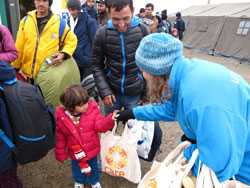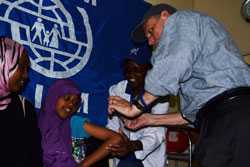World Refugee Day

Photo © US Embassy Nairobi/K.Alderman
June 20th marks World Refugee Day, a day in which the Centers for Disease Control and Prevention (CDC) joins with the rest of the world to honor the courage and resilience of the world’s refugees. Observing World Refugee Day (themed “With Courage, Let Us All Combine”) gives all of us a chance to reflect on the alarming notion that every 4.1 seconds a person is displaced from his or her homeland as a result of war, famine, or natural disaster.
In 2015, close to 60 million people were forced from their homes due to conflict and disasters. According to the United Nations Refugee Agency (UNHCR), “An unprecedented 59.5 million people around the world have been forced from home. Among them are nearly 20 million refugees, over half of whom are under the age of 18. There are also 10 million stateless people who have been denied a nationality and access to basic rights such as education, healthcare, employment and freedom of movement.”
CDC works every day to bring hope and comfort to refugees. Two branches that are at the forefront of this effort, the Emergency Response and Recovery Branch (ERRB) and the Immigrant, Refugee and Migrant Health Branch (IRMH), help promote and protect the health of refugees in complex humanitarian disasters and those undergoing resettlement to the United States, respectively.

On-the-ground personnel distribute packages to children on St. Nicholas Day at the Slavonski Brod transit center in Croatia. The total time in the transit camp has decreased from 4-6 hours to 1 hour, significantly affecting time allowed to provide services.© UNHCR/S. Osterman
The Global Response
Today’s global crises require experts who can quickly respond to health emergencies and provide leadership and needed skills. Within the Center for Global Health’s Division of Global Health Protection (DGHP), ERRB is committed to helping countries prepare for, respond to, and recover from global public health issues related to natural disasters, war, and civil strife.
ERRB implements and coordinates CDC’s responses to global humanitarian emergencies, as requested by partners from the U.S. government, United Nations agencies, and non-governmental organizations. From setting up surveillance systems days after a major earthquake, to evaluating feeding programs in post-conflict settings, these emergency response and recovery experts travel the world to work with populations affected by emergencies.
“Our work includes everything from planning immunization campaigns, improving water and sanitation, and caring for pregnant women and their families to detecting outbreaks of communicable diseases,” notes ERRB Branch Chief Mike Gerber. “Our experts help increase the odds that sound decisions are made and public health systems are strengthened.”
ERRB’s dedicated teams of experts include:
- The Global Response Preparedness Team works with international partners and Ministries of Health to develop plans and procedures for handling emergencies. They also help countries develop their own Emergency Operations Centers, where highly trained experts can gather to exchange information and make decisions quickly in a crisis.
- The Humanitarian Health Team provides expertise in critical areas like assessment; emergency risk communication; evaluation; information management; health, injury, and protection; mental health; non-communicable diseases; nutrition; reproductive health; surveillance; statistics, and vaccine-preventable disease.
- The Global WASH Team, which cuts across three centers— the National Center for Emerging and Zoonotic Infectious Diseases, the Center for Global Health and the National Center for Environmental Health—coordinates CDC’s response and collaborates with the Global WASH cluster to help ensure the delivery of water, sanitation, and hygiene assistance during global emergencies and disease outbreaks and in refugee settings. In addition to responding to emergencies, the team also works with partners to provide training and help strengthen WASH systems.
- The Global Rapid Response Team provides staff who can rapidly deploy anywhere in the world to help CDC experts respond more effectively to global public health emergencies.
- The Public Health Systems Recovery Team works with partners to rebuild public health systems after a global disaster. This team was initially established and worked with partners to help strengthen the public health system following the 2010 Haiti earthquake, and has now expanded efforts to work with other countries impacted by public health crises.
As the world’s population of refugees, asylum-seekers, and those displaced from their homes continues to climb, ERRB remains committed to helping those impacted by global conflict and crises.
IRMH works overseas to promote and improve the health of refugees undergoing resettlement to the United States. Housed within the Division of Global Migration and Quarantine (DGMQ), IRMH’s key partner include the UNHCR, the U.S. Department of State’s Bureau of Population, Refugees, and Migration (PRM), and the International Organization for Migration (IOM).

Mr. Robert Godec, U.S. ambassador to Kenya, places an adhesive bandage on the arm of a vaccinated girl in Kakuma Refugee Camp. Refugees receive vaccines overseas to protect their health and the health of host communities in the U.S. where they will resettle. © US Embassy Nairobi/ K.Alderman
“To promote refugee health, we provide guidelines for disease screening and treatment in the U.S. and overseas, provide instructions for how medical examinations of refugees should be performed, track and report disease in refugee populations, develop refugee health profiles, respond to disease outbreaks in the U.S. and overseas, and in partnership with IOM and PRM [International Organization for Migration and U.S. State Department’s Bureau of Population, Refugees and Migration], provide vaccinations overseas to control vaccine-preventable diseases and medicines to prevent malaria and eliminate intestinal worms,” said IRMH Chief Nina Marano.
Key resources include:
- DGMQ’s Africa Field Program in Kenya
- DGMQ’s Asia Field Program in Thailand
- Technical Instructions for Panel Physicians and Civil Surgeons
- Overseas Interventions
The Domestic Response
What happens to refugees after they arrive in the United States?
To ensure that U.S.-bound refugees and immigrants have continuity of care after their arrival, IRMH’s Domestic Program works closely with the Health and Human Services’ Office of Refugee Resettlement, state health departments, refugee resettlement agencies, and other local partners to monitor the health of refugee populations. IRMH’s primary partner in these endeavors is the Association of Refugee Health Coordinators, an organization representing U.S. jurisdictions that have refugee health programs.
Through additional partnerships, such as cooperative agreements with 10 U.S. state health departments and two Centers of Excellence in Refugee Health, the Domestic Program is able to compile post-arrival refugee health information from many jurisdictions, improving surveillance and informing guidelines for clinicians.
The development of health education strategies and guideline development are integral components of the Domestic Program. Evidenced-based recommendations for routine post-arrival medical screening of refugees assist state public health departments and clinicians who screen refugees and ensure that refugees receive proper care upon their arrival in the United States.
Additionally, the Domestic Program has produced Refugee Health Profiles of specific refugee populations, which provide targeted cultural and health information about these groups. These profiles enable physicians and other caregivers to provide culturally competent care.
IRMH also strives to develop culturally appropriate health education messages for newly arrived refugees.
“Information about prevention and management of seasonal flu, for example, was developed through focus groups and educational sessions conducted with refugees in their native languages,” said Marano. “They are tailored for low literacy populations by using minimal text and visual cues to portray seasonal flu information.”
The current global refugee crisis has created an urgency for building domestic and international capacity to meet the diverse healthcare needs of refugees, as well as raise awareness among healthcare and public health professionals about refugee health. In addition to its recognition of World Refugee Day 2016, CDC, along with its key partner agencies and organizations, will continue collaborating on strategies to promote and improve refugee health.
“CDC and our partners continue to help refugees at home and abroad; at this time, it’s critically important that we work together to protect the health of the world’s most vulnerable populations,” said Marano.
- Page last reviewed: June 20, 2016
- Page last updated: June 20, 2016
- Content source:
- National Center for Emerging and Zoonotic Infectious Diseases
- Page maintained by: Office of the Associate Director for Communication, Digital Media Branch, Division of Public Affairs




 ShareCompartir
ShareCompartir